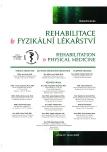Evaluation Dynamic Postural Stability – Creation of Reference Values for a Common Young Population in the Czech Republic
Authors:
H. Vomáčková; D. Pavlů; D. Pánek
Authors‘ workplace:
Katedra fyzioterapie, Fakulta tělesné výchovy a sportu UK, vedoucí katedry PhDr. T. Nováková, Ph. D.
Published in:
Rehabil. fyz. Lék., 27, 2020, No. 2, pp. 99-107.
Category:
Original Papers
Overview
In clinical practice, postural stability of standing position is most frequently tested by basic techniques using simple functional tests or by means of more complex scales and batteries, which do not only evaluate balance in the standing position, but at also associated with other functional tests in the standing position, changes in position and walking. For the objective evaluation of postural stability, the most frequently used are force workout platforms, which serve for measuring of reaction forces acting from the platform, or pressure platforms meant for measuring pressure caused by the contact of feet with the platform.
The paper describes the use of the system evaluating dynamic postural stability by means of the dynamic computing posturography NeuroCom SMART EquiTest System, which is most frequently used for evaluating clinical conditions of the patients with balance disorders.
From the experience obtained in processing the studies using the above-mentioned system in came out that numeric values of and standardized data, presented by the produced Natus Medical Incorporated, considering their adjustment are not for the diagnostics of balance disorders, sufficiently sensitive form evaluating parameters of dynamic postural stabilization in a common young population.
The study is therefore devoted for presenting the determined reference values of selected parameters of dynamic postural stabilization of NeuroCom SMART EquiTest System for the age group between 20 – 30 years of age.
In the purposely selected group of 50 healthy probands (25 men and 25 women) at the age of 20 to 30 years (25±22), the equally maintained testing conditions provided parameters of testing protocols offered by NeuroCom SMART Equitest System: Sensory Organization Test (SOT), Motor Control Test (MCT) and the Adaptation Test (ADT).
The results were evaluated by the same methodology, as the normative values published in manuals of the testing system.
The resulting data of several parameters of the described tests obtained, resented as reference values (REF 20-30) for the group of young healthy individuals at the age of 20-30 years, who live in the Czech Republic and appear be markedly more sensitive for evaluation dynamic postural stability of a common population actively performing sports.
Keywords:
NeuroCom SMART EquiTest System – reference values – dynamic postural stabilization – SOT – MCT – ADT
Sources
1. BIZOVSKÁ, L. et al.: Rovnováha a možnosti jejího hodnocení. Olomouc, Univerzita Palackého v Olomouci, 2017.
2. CONCORDIA UNIVERSITY: NeuroCom SMART EquiTest Computerized Dynamic Posturography (CDP). Montreal, Concordia University PERFORM Centre, 2015, 3rd ed. revised, 24 s.
3. GODI, M., at al.: Comparison of Reliability, Validity, and Responsiveness of the Mini-BESTest and Berg Balance Scale in Patients With Balance Disorders. Physical Therapy [online], roč. 93, 2013, č. 2. [cit. 2020-01-03]. ISSN 0031-9023. Dostupné z: doi: 10.2522/ptj.20120171.
4. HONZKOVÁ, Z.: Hodnocení vlivu cvičení „plank“ na posturální stabilitu jedince. Praha, 2017. Diplomová práce. Univerzita Karlova, Fakulta tělesné výchovy a sportu. Vedoucí práce Mgr. Helena Vomáčková.
5. KLOCOVÁ, K.: Vliv spánkové deprivace na posturální stabilitu. Praha, 2015. Diplomová práce. Univerzita Karlova, Fakulta tělesné výchovy a sportu. Vedoucí práce PhDr. Tereza Nováková, Ph.D.
6. MAIER, L.: Vliv komplexního strečinku dolní končetiny na posturální stabilitu. Praha, 2014. Diplomová práce. Univerzita Karlova, Fakulta tělesné výchovy a sportu. Vedoucí práce PhDr. Lenka Žáková, Ph.D.
7. NATUS MEDICAL INCORPORATED.: Clinical Interpretation Guide. Seattle, NeuroCom® Balance Manager® Systems, 2013, 171 s.
8. NATUS MEDICAL INCORPORATED.: Clinical Operation Guide. Seattle, NeuroCom® Balance Manager® Systems, 2014a, 238 s.
9. NATUS MEDICAL INCORPORATED.: Instructions for use Seattle, NeuroCom® Balance Manager® Systems, 2014b, 55 s.
10. NATUS MEDICAL INCORPORATED.: Instructions for use Seattle, NeuroCom® Balance Manager® Systems, 2016, 54 s.
11. NEUROCOM INTERANTIONAL.: Balance Manager System, Clinical Operations Guide: Appendix. Clackamas, Neurocom Interantional, 2008a, 305 s.
12. NEUROCOM INTERANTIONAL.: Balance Manager System, Clinical Operations Guide. Clackamas, Neurocom Interantional, 2008b, 120 s.
13. NOVÁKOVÁ, T., et al.: Screening pohybového systému školních dětí (7 až 12 let) v Praze. Rehabilitace a Fyzikální Lékařství, 2017, 4, 24 s.
14. SHEPARD, N.,T.: Interpretation and Usefulness of Computerized Dynamic Posturography. In: Jacobson GP SN, ed. Balance Function Assessment and Management. San Diego, Plural Publishing, 2008, s. 359-378.
15. VRUBELOVÁ, L.: Vztahy mezi motorickými testy a parametry dynamické posturální stability. Praha, 2017. Diplomová práce. Univerzita Karlova, Fakulta tělesné výchovy a sportu. Vedoucí práce Mgr. Helena Vomáčková.
Labels
Physiotherapist, university degree Rehabilitation Sports medicineArticle was published in
Rehabilitation & Physical Medicine

2020 Issue 2
Most read in this issue
- Piriformis Syndrome and FAIR Test from the View of Magnetic Resonance
- Evaluation Dynamic Postural Stability – Creation of Reference Values for a Common Young Population in the Czech Republic
- Practical Use of PolyEMG in Rehabilitation. Poutpatient’s. Surface Electromyography (SEMG) and EMG Biofeedback
- The Influence of Phy-siotherapy for Female Urinary Incontinence
